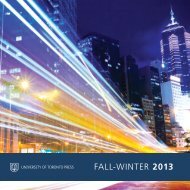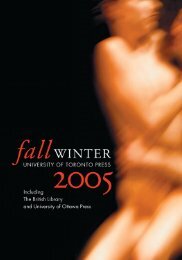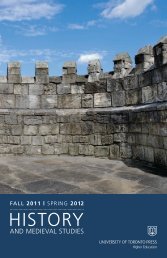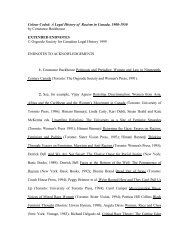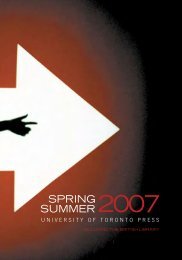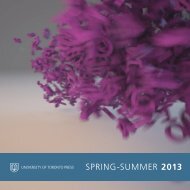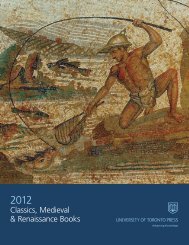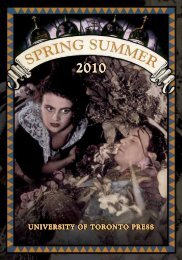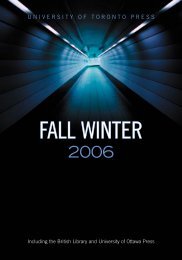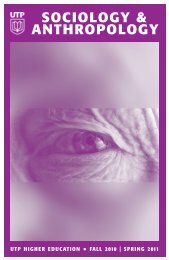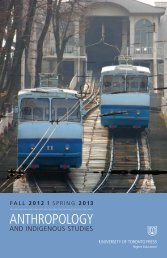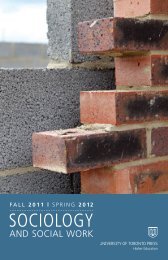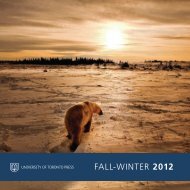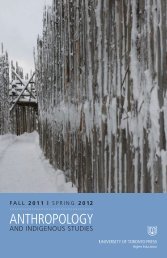Spring/Summer 2005 - University of Toronto Press Publishing
Spring/Summer 2005 - University of Toronto Press Publishing
Spring/Summer 2005 - University of Toronto Press Publishing
You also want an ePaper? Increase the reach of your titles
YUMPU automatically turns print PDFs into web optimized ePapers that Google loves.
ITALIAN STUDIESAn Italian Renaissance SextetSix Tales in Historical ContextLauro MartinesTranslations by Murtha BacaTHE LORENZO DA PONTE ITALIAN LIBRARYAn Italian Renaissance Sextet is a collection <strong>of</strong> sixtales <strong>of</strong>fering a unique view <strong>of</strong> the history <strong>of</strong>Renaissance Italy, with fiction and fictional modesbecoming gateways to a real, historical world. Allwritten between 1400 and 1500 – among them arare gem by Lorenzo the Magnificent and a famousaccount featuring Filippo Brunelleschi – the storiesare presented here in lively translations.As engrossing, fresh, and high-spirited as thosein Boccaccio’s Decameron, the tales deal with marriage,deception, rural manners, gender relations,social ambitions, adultery, homosexuality, and thedemands <strong>of</strong> individual identity. Each is accompaniedby an essay, in which Lauro Martines situatesthe story in its temporal context, transforming itinto an outright historical document. The storiesand essays focus mainly on people from the ordinaryand middling ranks <strong>of</strong> society, as they go abouttheir ordinary lives, under the pressure <strong>of</strong> a highlypractical, conformist, pleasure-loving (but <strong>of</strong>tencruel) urban society. Revealing the concerns <strong>of</strong> asearching historical work with a combined anthropological,demographic, and cultural slant, AnItalian Renaissance Sextet shines a probing light onItalian Renaissance culture.… as the friar continued to beg the damsel to satisfy his love,and the young priest continued to refuse, the friar became allinflamed with desire. And unable to change his mind withprayers, gifts, and extravagant promises, he seized him andthrew him on the bed. Now the young priest, finding himselfon his back and thinking it was time to reveal his identity,suddenly changed his fake Florentine accent and spokein the accent <strong>of</strong> Arezzo, saying: “My dear sir, don’t overexertyourself, for I am more a man than you are.” Amazed andwanting an immediate explanation, the friar put out hishand and felt that the “young lady” was a very well-endowedyoung man. But seeing how handsome he was, feeling allaflame with desire, and determined to satisfy his unrulyappetite, he said: “Very well! I like you no less as a man thanas a woman.” Then the young priest, rather alarmed by this,quickly pushed his feet against the friar’s shameless breast,knocking him backward, and jumped <strong>of</strong>f the bed …From ‘Friar and Priest’Lauro Martines is an author and independent scholarwho has taught history in Los Angeles, London,and Paris.Murtha Baca is head <strong>of</strong> the Standards and VocabularyPrograms at the Getty Research Institute.278 pp / 6 x 9 / AvailableCloth ISBN 0-8020-8993-3 £32.00 $50.00 EPaper ISBN 0-8020-8650-0 £15.00 $24.95 CApollo and Daphne by Antonio del Pollaivolo (1432–98). Oil onwood, 1470–80. Courtesy the National Gallery, London.35



